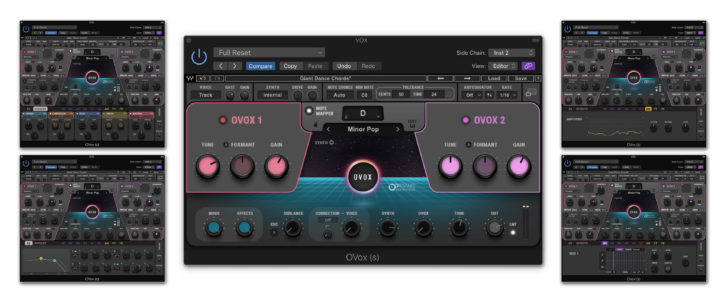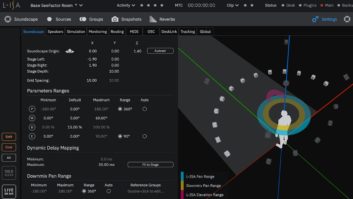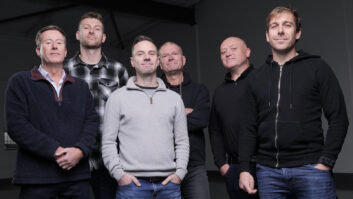
AKG K361-BT/K371-BT Professional Studio Headphones
AKG, a Harman company, first showed its new headphone line—the K361-BT and K371-BT featuring Bluetooth connectivity—at a 70th anniversary bash at Capitol Studios last December, featuring special guest Quincy Jones. The K361-BT and K371-BT feature an over-ear, closed-back design with plush, ergonomic earcups that swivel 90 degrees. They weigh less than 8 ounces and frequency response is published at a stunning 15 Hz to 28 kHz in the K361-BT and 5 Hz to 40 kHz in the K371-BT. Both models offer switchable Bluetooth 5.0 wireless and wired connectivity, with a built-in microphone. K361-BT and K371-BT professional headphones feature high-sensitivity, largest-in-class 50mm drivers and pure oxygen-free copper voice coils to deliver clear, detailed and balanced lows, mids and highs.

L-Acoustics Kara II
Based upon its successful Kara Line Array, L-Acoustics has introduced the Kara II Long Throw Line Source. Each Kara II enclosure is a two-way system employing dual 8-inch neodymium low-frequency cone drivers and one 3-inch neodymium high-frequency compression driver. Bandwidth is specified as 55 Hz to 20 kHz, with a maximum SPL of 142 dB (@ 70-degree symmetric). Input and link connections are available via four-pole SpeakOn connectors, and a four-point captive rigging system facilitates inter-enclosure angles of 0, 1, 2, 3, 4, 5, 7.5 or 10 degrees. Kara II features Panflex, which enables the enclosure to provide four different horizontal coverage patterns, including 70-degree or 110-degree symmetrical, or 90-degree asymmetrical on either side.

Waves OVox Vocal Processor
Waves made a big splash at NAMM with OVox, a powerful and deep vocal processor and synthesizer that runs as a plug-in or as a stand-alone application. OVox combines vocoding with harmonization, pitch correction, doubling and more, and it features two identical processing sections (OVox 1 and 2), which provide the vocoder and synth effects (an 8-voice synth is built-in). You can turn on one or both processors. The Advanced mode features a more extensive selection of adjustable parameters. Some examples are a 4-band EQ, a Noise Generator and a Formant Filter. You also have access to a modulation section, which lets you apply LFOs, a step sequencer and what Waves refers to as the “Organic Modulators.” These include amplitude, pitch and formant data extracted from the source signal. OVox can be controlled by the source audio, audio from another track, an external source through the sidechain, or by incoming MIDI from another track or a MIDI keyboard.

Lectrosonics MTCR (Miniature Time Code Recorder)
Lectronsics has introduced a new tiny digital recorder, the MTCR (Miniature Time Code Recorder), which can travel with the subject and capture professional quality audio, synchronized with timecode. The MTCR records in 24-bit, 48 kHz digital onto a microSD card (HC type, Class 10) in the industry-standard .wav format. The unit can be jammed to external time code via the standard 5-pin Lemo connector. A headphone output jack allows for monitoring the signal input or listening to previously recorded files, but cannot be used to send live audio to another device while recording. The input connector is the industry standard TA5M jack that accepts any mic or line level signal and provides bias voltage to power a wide variety of electret lavalier microphones. The housing is manufactured from tough aluminum alloy then hard anodized for the ruggedness needed in field production. The MTCR runs for over six hours on a single lithium AAA battery. Audio specifications: 20 Hz–20 kHz frequency response, 105 dB(A) signal-to-noise (in HD mono mode), <0.035% distortion. Time code is SMPTE 12M – 1999 compliant.

Steinberg UR24C Audio Interface
Steinberg has announced a compact, powerful 2-channel audio interface with 32-bit/192 kHz audio resolution and flexible headphone monitoring modes ideal for recording and performing. As with each UR-C interface, the UR24C provides USB Type-C (USB 3.1 Gen 1 SuperSpeed) connectivity and features 32-bit/192 kHz audio resolution, MIDI and delivers DSP power for using effects when monitoring audio without latency. It includes two balanced Neutrik combo inputs, high-grade D-PRE microphone preamps, two TRS main outputs, four RCA line outputs, and MIDI in and out. Its specialty lies in the switchable monitor modes for headphones: DAW mode is used for producing music with a DAW, such as Cubase or Nuendo, where the signal from output 1 or output 2 is chosen as the headphone source while allowing the user to adjust the balance of the signals from the DAW and from the UR24C’s inputs; DJ mode is expected to be used for performances with DJ software and backing tracks where the signal is split so the mono master sound is output to the right side of the headphones and the mono cue sound to the left, also letting the user adjust the balance of both signals.







